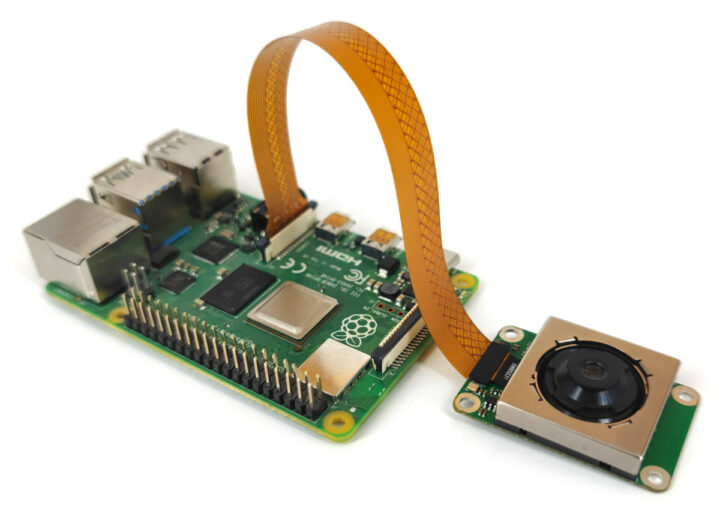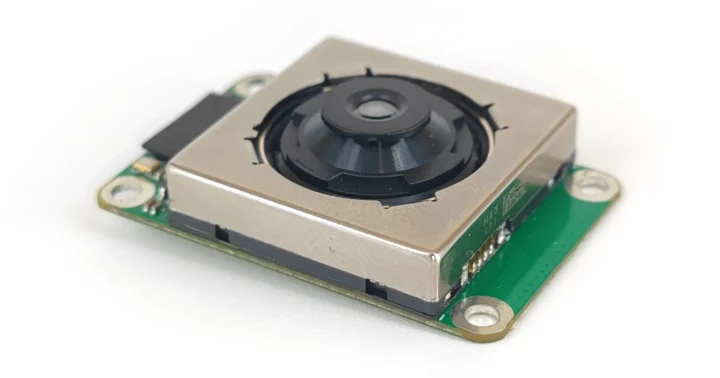RBTS.co’s C50M camera module is equipped with the same 8K 50MP Samsung ISOCELL GN2 image sensor found in the upcoming Google Pixel 8 Pro smartphone but targets the maker market with support for NVIDIA Jetson, Raspberry Pi, and Rockchip RK3588 boards.
With high-resolution and quick focusing ability, this camera sensor is designed for drones, machine vision, and industrial automation applications such as automated optical inspection and preventive maintenance, and the large 1.4μm pixels of the Samsung ISOCELL GN2 sensor are said to make the camera work well in low-light conditions.
C50M camera module specifications:
- Effective Resolution – 8,160 x 6,144 (50MP)
- Pixel Size – 1.4μm (2.8μm with 12.5MP binning)
- Optical Format – 1/1.12″ sensor
- Color Filter – Dual Tetrapixel RGB Bayer Pattern
- Frame Rate – 30fps @ 50MP, 120fps @ 4K and 480fps @ FHD
- ADC Accuracy – 10-bits
- Chroma – Tetra
- Auto Focus – Dual Pixel Pro (PDAF); range: 15cm to infinity
- WDR – Smart-ISO Pro (iDCG), Staggered HDR
- Output Formats – RAW8 (using DPCM/PCM compression) and RAW10
- HDR (stacking) output formats – RAW12 and RAW14
- Analog Gain – x16 @ 50MP, x64 @ 12.5MP
- Lens F-number – 1.82
- TLL – 8.3mm
- EFL – 6.811mm
- Field of View – 90°
- Host interface – 22-pin 0.5mm pitch FPC connector for 4-lane MIPI CSI-2 (6.5Gbps per lane), I2C, frame-sync output
- Supply Voltage – 3.3 – 5V
- Dimensions – 40 x 26 x 12 mm; mounting holes: 4x M2.5 holes in a 35 x 21 mm rectangle
- Weight – 12 grams
- Temperature Range – -20°C to +85°C
The C50 camera module is still in development with only 8 prototypes available at this stage. RBTS.co is still working on drivers for NVIDIA Jetson boards, the Raspberry Pi SBCs, and their own Rockchip RK3588-powered Machine Learning-focused platform for which there’s no detail at this time.
This may explain why they shared a video made by Samsung two years ago about the ISOCELL GN2 sensor instead of their own promotional video… Still, they have an aggressive development schedule with shipping in November 2023 to backers, or even in September 2023 for early backers.
The C50M 8K 50MP camera module has just launched on Indiegogo with a 33,500 Euros (about 36,650 USD) funding goal. Rewards start at 89 Euros for the early bird perk that includes the camera module, a 150mm 22 to 22-pin FFC cable, and a 150mm 22 to 15-pin FFC cable. The same kit goes for 119 Euros for backers who prefer to play it safer and get it shipped in November 2023 after some beta testing has taken place. Shipping adds an extra 15 Euros. Further details may also be found on the company’s website.

Jean-Luc started CNX Software in 2010 as a part-time endeavor, before quitting his job as a software engineering manager, and starting to write daily news, and reviews full time later in 2011.
Support CNX Software! Donate via cryptocurrencies, become a Patron on Patreon, or purchase goods on Amazon or Aliexpress







Thank you for posting my pet project and getting the word out! I’ll do my best to answer any questions here in the comments.
Is it possible to remove the lens ?
Yes, M18x0.2 thread. The VCM would need to be disabled (I suppose) as well, unless you want to replace it with a similar item.
How does the AF work if you swap out the lens?
Can you acquire pictures faster in a 2×2 binning mode for 12.5MP? I’m always skeptical of resolution much higher than that, since most lenses can’t really resolve anywhere near 50MP on such small sensors.
Any idea what the final retail price will be, post-crowdfunding?
The lens can be swapped, keeping AF working, but it’s not something we can support right away, it would take too much time away from the things needing done first. The VCM is closed loop though, so that’ll help. Of course feel free to test. The binning mode can indeed capture pictures faster, by lowering the amount of data transferred and shortening the integration time. Up to 4x faster approx. Retail pricing is likely going to be $200 or more, part to start regaining some of the engineering costs, part because they’ll be sold through a distributor. Which is more… Read more »
Will you support rock 5b?
I reached out to them to see if they’d be interested. I would be happy to make the Rock 5B work, if Radxa is willing to help with their board specifics.
How raw can it go with output, that is, skipping all the post-processing, HDR features and 100MP upscaling?
The raw image format is ‘tetrapixel’, a variant on Quad Bayer where each green subpixel is again split in two (but share one micro-lens).
So the 100MP mode isn’t actually upscaling, the default 50MP mode uses merged green subpixels. The sensor can & will output either as RAW10 (native 10-bit ADC).
I see, then again, is there a mode for getting raw tetrapixel data?
Yes, there is. The sensor can output raw 50MP, raw 100MP and 50MP bayer (the latter interpolated / reconstructed, for boards not supporting QB processing). Besides of course binning / scaled / cropped resolutions.
About time we get a decent camera for the pi! Thanks! Any chance for an it filter free version, or cooler still aswitchabkw filter?
That would take a custom production run, so as soon as enough people would like such a version it’s something I can arrange.
Thanks for this project. Is the driver on Pi and nvidia support all features in the video. Is it going to be supported on all nvidia jetson boards
Not all platforms support all features of the camera, the limitations depend a little on the platform. But most features should work on the RK3588 and newer / higher-end Jetsons. I’ll do my best to get the drivers tested on as many Jetson platforms I can get my hands on.
Is the lens using a standard mounting? What kind of adapter would we need to put e.g. a C-mount lens?
Do you think it would work well with a strong magnification lens (e.g. for PCB inspection)?
The nearest focus distance for the included lens is 15cm. It’s not something I’d call a standard lens mount. For PCB inspection I’d personally use a global shutter sensor with a fixed focus lens (as a matter of fact, I am using my own AR0234CSSM 2.3MP monochrome modules for MV inspection tasks).
Why not mention Xiaomi Mi 11 Pro/Ultra instead of the unreleased Pixel 8. They were actually pretty good.
They certainly are pretty good, the Mi 11 Ultra was what got me to try and chase this sensor in the first place. But I also noticed it’s not a well known phone, taking a lot of explanation, whereas when mentioning the Pixel people go ‘ahh, ok, yes’ a lot more often. 🙂
What framerate at 50MP can be reached on a raspberry pi?
If I remember correctly it has only 2 csi-2 lanes but I couldn’t find the supported data rates on the lanes on a RPI.
50MP * 30fps * 8 bit/pixel = 12gbit/s. Divided by two lanes are 6 gbit/s per lane which is quite a lot. This article mentions compression, but I couldn’t find any info about at achievable compression factors.
Can’t really say yet, as there are quite a few factors influencing this, as you already highlight. I felt it better to not give figures for the Pi and stick to the sensor specs with a note than to make some inaccurate claim.
Your probably not going to get anywhere near 50MP, the lanes seems to 1Gbps as per this thread plus the overhead of ISP processing by GPU. If you look at the specs for rpi HD camera it’s going to be in that range for 2 lanes. I assume for this project they will need to write the ISP code for it to be useable.
For Jetson thing are even more tricky the ISP can only be tuned by an Nvidia Camera Partner and quotes are ridiculously expensive. Its simpler to buy a camera module from one of the partners.
Will the full sensor documentation be available without an NDA? We intend to develop a mipi-CSI2 core for a FPGA to support all 4 lanes at full speed via Kintex7 GTX Serdes.
Sorry, that’s not up to me to publish. You’d have to arrange NDA access in some way.
Does this camera have global shutter? How long would it take after making a picture before I can take the next, using a RPI4?
It has a rolling shutter. The integration time (ADC time required to sample all subpixels) is dependent on (amongst other things) the amount of light coming in and the amplifier gain. But on the Pi you’re more likely to hit the bandwidth limit of the Pi camera interface (the CM4 has twice the amount of CSI-2 lanes btw).
That’s a pity. A rolling shutter makes it virtually impossible to use on drones, due to movement and vibrations. But thanks for the answer.
It seems this project failed to achieve it’s target